Follow Scott
Recent Tweets
- Waiting for Twitter... Once Twitter is ready they will display my Tweets again.
Latest Photos
Search
Tags
anniversary Balticon birthdays Bryan Voltaggio Capclave comics Cons context-free comic book panel conventions DC Comics dreams Eating the Fantastic food garden horror Irene Vartanoff Len Wein Man v. Food Marie Severin Marvel Comics My Father my writing Nebula Awards Next restaurant obituaries old magazines Paris Review Readercon rejection slips San Diego Comic-Con Scarecrow science fiction Science Fiction Age Sharon Moody Stan Lee Stoker Awards StokerCon Superman ukulele Video Why Not Say What Happened Worldcon World Fantasy Convention World Horror Convention zombies
©2025 Scott Edelman
Something I can’t quite figure out about romance cover art
Posted by: Scott
Tags:
comics, Irene Vartanoff, John Tartaglione
Posted date:
February 16, 2013 |
9 Comments
Well, Valentine’s Day was this week, which means my thoughts turned to romance … romance comic books, that is. It reminded me of a dichotomy I noticed several years ago between the covers to romance novels and the covers to romance comics, a difference I’ve never seen anyone mention. And so I figure I should mention it to you here now so that you can go, “Oh, Scott, you dummy, where have you been, everyone already knows that!”
It started for me back in 2006, as Irene and I were approaching our 30th anniversary. I decided that, because of Irene’s love of both romance novels and comic books, I’d buy her the original art to a romance comic book cover for an anniversary gift. What I soon discovered, as I studied all the art then for sale from dealers, was that romance comic book cover art was terribly sad, and not at all suitable to celebrate three decades of love!
Somehow, even though our house has always been filled with both romance novels and comics, I’d never noticed this.
Take a look at the covers to a couple of random romance novels.
They depict (or seem to anyway, since we have no idea what the characters are really thinking) people in love. And more than just in love, happy in that love. What you’re seeing is the aspirational goal of a romance—its, yes, “happily ever after” loving conclusion.
Romance comic book covers, on the other hand, don’t do that, and never have, not since the beginning, when Joe Simon and Jack Kirby invented the romance comic.
Take a look at the first cover to the first issue of the first romance comic book ever—Young Romance #1 from 1947. As you can see, the cover illustrates a soap opera problem, as opposed to a romance story conclusion.
I should have known this. My seemingly impossible search for a comic book cover that delivered the bliss of a romance novel cover shouldn’t have been surprising. Because the romance comics published during my teens, back when I read any comic I could get my hands on, continued that trend.
Oh, I’m sure there must be a few exceptions out there, but as far as I can see, there is no happiness to comic book romance covers, only fear, remorse, anxiety, regret, guilt, and a host of other prickly emotions, none of which would sum up thirty years of a loving marriage, and none suitable for an anniversary gift.
And the strangest thing is … I had, and still have, no idea why.
I was about to give up on my quest for a cover I felt would embody my love for Irene, when one dealer asked whether I’d instead consider the original to an interior page. I rather unenthusiastically agreed to take a look, and was stunned when it turned out to be the perfect gift. It was the final page to a four-page story from Love Tales #73.
In its six panels, it depicts what is the perfect fantasy conclusion to a genre romance (and yes, I know, that though that’s so for many, it’s not so for all; don’t worry, I’m not at all judging your particular fantasy)—a marriage, a return to a shared home, a new job, a bright future, and a promise that “it’s going to be all good from now on, darling!”
An added bonus was that the page had been drawn by John Tartaglione, someone Irene and I had worked with and, more importantly, both liked.
So the problem of a 30th anniversary gift had been solved, and the page now hangs on the wall of Irene’s office. But that didn’t solve the issue that’s been puzzling me since I began my quest.
Why?
Why is it that comic book romance covers (and I’m about to use the past tense here, because as far as I know they don’t exist any longer) pulled readers in by visualizing the messy process, while only the covers to romance novels were allowed to be aspirational, promising that what you see can (at least for a short time in fantasy) be yours? What’s the reason for such a schism?
I feel as if there’s a doctoral thesis demanding to be written comparing the two. (For all I know, one’s already been written.)
So—now it’s your turn. Anybody out there want to take a stab at explaining this to me? Has the reason for this competing style already been analyzed to death, and I’ve somehow managed to miss it all? Or is everybody else as puzzled as I am?
9 Comments for Something I can’t quite figure out about romance cover art
Scott
That’s a fascinating point. I hadn’t even considered the intermediary between the publisher and the reader, who must be appeased for that reader to be reached. Of course, there were magazine distributors between comics publishers and local stores as well, but it may have been a different fiefdom.
Thanks for the angle!
KB
Scott you raised an interesting point for me regarding romance comic covers. I have a reasonable collection of romance comics, and while I think you have observed a genuine phenomenon in that there may be a preponderance of ‘problem’ covers, it is by no means 100% the case. The Grand Comics Database provides a great resource for this kind of study. I did a quick search for ‘Heart Throbs’, a long-running romance comic title that was originally published by Quality Comics and then DC. Issue number 6 provides an example of a happy couple in love on the cover:
http://www.comics.org/issue/216553/cover/4/
There are some other examples, although I agree that the majority seem to depict problematic situations that precede the romantic conclusions of the tales told within. Even the titles of the stories suggest problems rather than successful outcomes. I think that romance stories, like most genres, include a phase where a spanner gets thrown in the works, and the conclusion the reader anticipates becomes threatened before it is achieved. Usually this negative turn of events becomes resolved in a manner satisfactory to the hoped-for conclusion, and thus the reader is gratified. That I think is a very broad generalization and not always adhered to. But it seems, as you say, that while the comic covers have a tendency to focus on that stage in the story when things are falling apart, the romance book covers skip to an image of a successful or satisfactory romantic outcome. I’m sure there’s some kind of statistical study that could be done to confirm the significance of your finding. Very interesting! I reckon there’s a full scale article in this topic!
That was a terrific observation made by Olivia. I would never have thought of the book covers being aimed at the vendors rather than the reader!
Scott
Thanks for the input! I did my best to make clear this wasn’t an absolute, but I do have a sense that if we were to do a census of all comic book covers and all novel covers, and then created a Venn diagram, that the overlap — that is, comic book covers with the happy clinch trope — would be a thin sliver.
Reading your comment, I find myself wondering whether this might be because the comics came from magazine publishers who were trying to make them like confession magazines, which always pushed problematic situations, rather than the novels, which were usually more aspirational.
Olivia Waite
In my excitement, I totally skipped over the bit where you described the romance novel cover as aspirational. You read the cover as representing the happy ever after? I’ve always thought it represented the moment when the burgeoning romance is threatened — by an outside force, or internal struggles on the part of the hero or heroine. It’s the moment where they acknowledge the passion they’re caught up in, but have no idea how to hang onto it. This moment would be much more in parallel with the dramatic conflicts on romance comics covers.
Scott
Yes, that is how I see those covers, with the comics representing the process, and the novels representing the prize, though I was careful to note about those novel covers that “we have no idea what the characters are really thinking.”
But whether the novel covers represent what I see or what you see, I hope we can agree that they do differ from the comic book covers, in that on a comic, a tear would be rolling down the woman’s cheek, and there’d be a thought balloon of her thinking something along the lines of, “How will I ever tell him that this can never be?”
J M Cornwell
I used to read romance comics back in the day. Considering the medium of comic book romance, like super hero comics and other comics, it’s always a dramatic scene that is depicted on the cover. I have always seen romance comics in the same vein. It’s a pivotal or dramatic moment that is depicted and the HEA is a given.
James
I don’t get your question that you answered yourself. Romance comics are soap operas in comic book form while books are not. I really like the comment from Olivia Waite, I would not have thought of that.
What I did think of is what I know from retail and comics. The romance comic covers are simply following the conventions of comic cover art, they show the drama in a way and size that can be seen from a few feet. Since Romance comics and Soap Operas are covering the same territory story wise they will share a lot in common: hence the Soap Opera seeming cover art. In a X-Man comic the drama will be some sort of violent conflict, in a romance comic the drama is not violent, it is emotional. In both cases the cover must show the source of the conflict. The happy ending is promised by the fact it *is* a comic. I can’t think of a non humorous comic that did have a happy cover. I also cannot think of a reason why someone like Kirby would change the nature of how he drew comic covers. If it worked for Captain America it would work here.
Book covers sell a smaller product from father away. In looking through the covers of my wife’s collection and I wouldn’t call them uniformly happy. In the two you show the Laura Ames is ambiguous, are they about to kiss or having a tense discussion, and the Barbara Cortland isn’t happy, the heroine has fainted for some reason and is need of passionate protection. What you do have is a man and a woman facing each other, nothing else is clear. In some modern Romances they are standing side by side. Google “Shotgun Sallys Susan Kearney” and check out the cover for “Out for Justice”. They are together and intense. I don’t see happy.
How Do You Read a Clinch Cover? - Olivia Waite
[…] the glorious Sequential Crush posted a link to Scott Edelman’s thoughtful reflection on the differences between romance comics covers and romance novel covers. He points out that […]

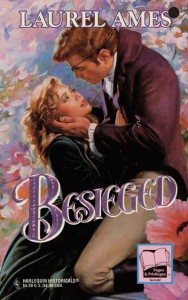
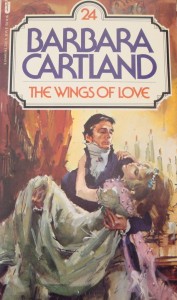
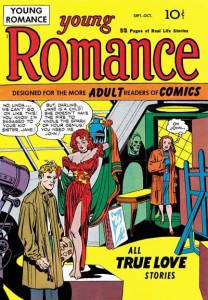
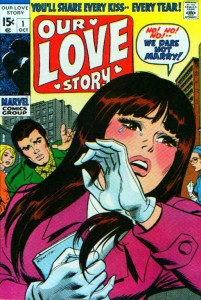
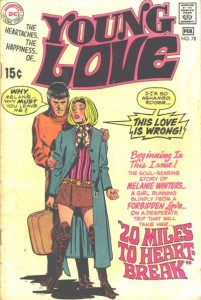
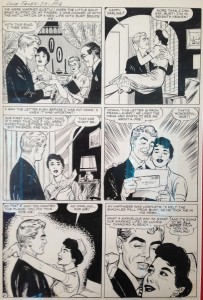
Olivia Waite
Geeky romance novelist here. 🙂 As far as I know, romance novels’ distinctive clinch covers (the wind-in-the-hair, half-naked embraces) were designed to sell not to the reader, but to the (usually male) purchasing agent for a book distributor. Over time these images became a code, so that now even modern self-published authors (who don’t have the same distribution bottleneck) use gowns and hair and half-naked embraces so the reader can recognize the story as a romance. I don’t know as much about romance conics, but it seems to me that the covers focus on a dramatic point in the story more than on implied sex — story is much more likely to be a selling point to the reader, who is much more personally invested in the contents of a book than a distributor is.
There’s probably also something to be sald for the different marketing strategies at play in the 30s, 40s, and 50s (for romance comics) and the 60s, 70s, 80s, and on (when romance novels came into their own).